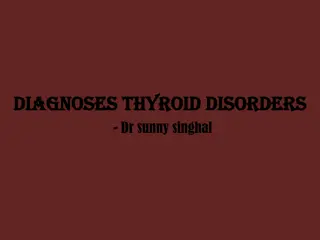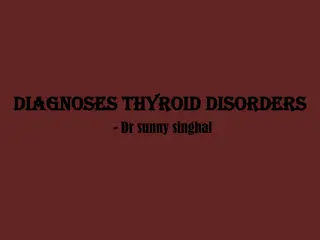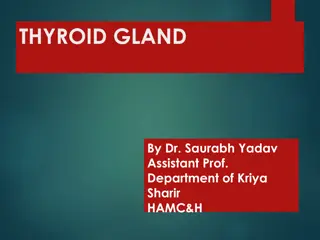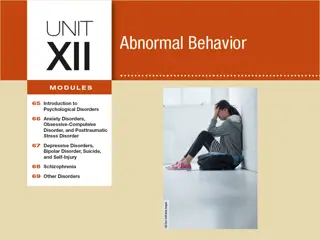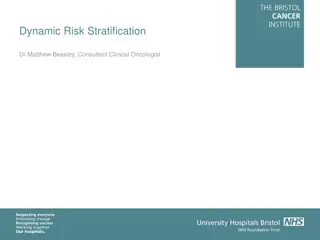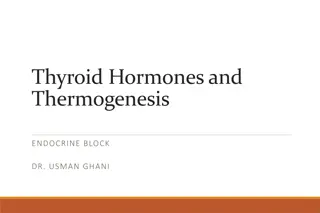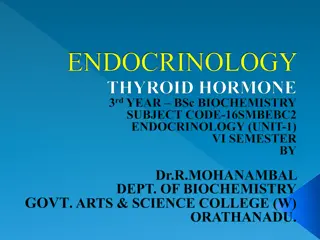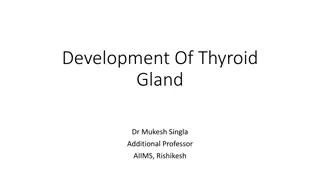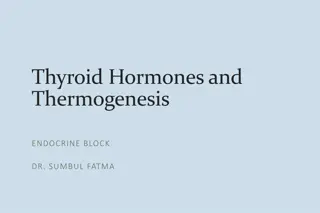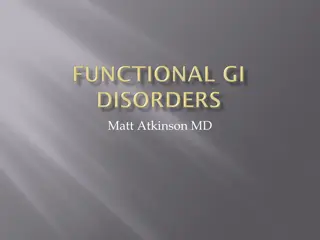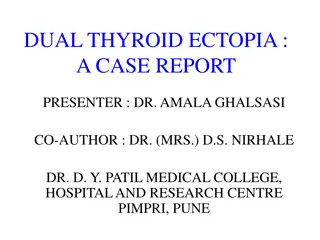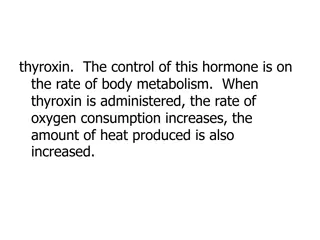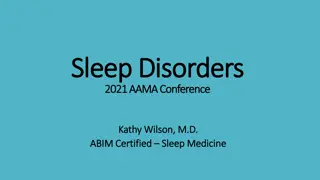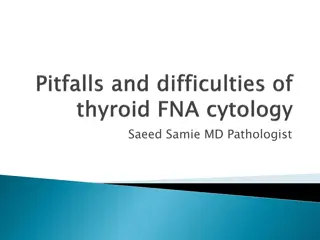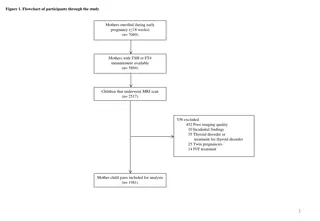Thyroid Disorders Overview & Learning Objectives
Explore the comprehensive overview of thyroid disorders, including hyperthyroidism, hypothyroidism, thyroid cancer, and more. Delve into learning objectives such as Grave's Disease, Thyroiditis, and Multiple Endocrine Neoplasia. This educational content covers essential information for understanding thyroid conditions and their management.
Download Presentation

Please find below an Image/Link to download the presentation.
The content on the website is provided AS IS for your information and personal use only. It may not be sold, licensed, or shared on other websites without obtaining consent from the author.If you encounter any issues during the download, it is possible that the publisher has removed the file from their server.
You are allowed to download the files provided on this website for personal or commercial use, subject to the condition that they are used lawfully. All files are the property of their respective owners.
The content on the website is provided AS IS for your information and personal use only. It may not be sold, licensed, or shared on other websites without obtaining consent from the author.
E N D
Presentation Transcript
Thyroid Thyroid Meghna Irukulla
Menti: 86 21 18 3 Learning Objectives Hyperthyroidism* Grave s Disease Thyroiditis Thyroid Nodules Hypothyroidism* Thyroid cancer Multiple Endocrine Neoplasia Carcinoid syndrome Acromegaly* Hypogonadism*
Disclaimer MedED does not represent the ICSM Faculty or Student Union. This lecture series has been designed and produced by students. We have made every effort to ensure that the information contained is accurate and in line with featured on SOFIA, however, this guide should not be used to replace formal ICSM teaching and educational materials. Learning Objectives
Menti: 86 21 18 3 SBA 1 A 45-year-old female was referred to the endocrinology clinic following complaints over the past month of always feeling very hot, sweating constantly and experiencing palpitations. requested blood tests to investigate the underlying cause. The findings are as follows: The endocrinologist had Thyroid Stimulating Hormone (TSH) low Free thyroxine (T4) high TSH receptor stimulating antibodies positive What further finding would support the likely diagnosis? A. Multinodular goitre B. Pretibial myxoedema C. Smoothly enlarged tender goitre D. Thinning of hair E. Weight loss
Menti: 86 21 18 3 SBA 2 A 66-year-old woman is admitted to A/E with acute confusion. On examination, she is overweight, there is non-pitting oedema affecting the eyes and legs, and she has dry skin and coarse hair. She has a heart rate of 50 beats/min, blood pressure of 90/60mmHg, respiratory rate of 10 breaths/min, temperature of 30 C, and oxygen saturation of 90% on air. Which of these medications should she be started on? A. Propylthiouracil B. IV Propanalol C. Enalapril D. IV Liothyronine sodium E. Octreotide
Thyroid TRH TSH Metabolic Effects T3/T4
Thyroid Hyperthyroidism Hypothyroidism Weight loss Heat intolerance Restlessness Palpitations Weight gain Cold intolerance Lethargy Bradycardia General Cardiac Skin/ hair Increased sweating Dry Skin, brittle hair Diarrhoea Oligomenorrhoea Constipation Menorrhagia GI Gynae Hyperreflexia Tremor Decreased reflexes Carpel Tunnel Neuro
Hyperthyroidism Aetiology Excess circulating T3/T4 due to: 1. Increased thyroid hormone synthesis 2. Increased thyroid hormone release
Hyperthyroidism Aetiology 1. Increased thyroid hormone synthesis Graves Disease Most common cause of hyperthyroidism TSH Receptor Antibodies (TRAb) Grave s triad 1. Exopthalmos 2. Thyroid Acropachy 3. Pretibial Myxoedema 2. Increased thyroid hormone release De Quervain s Thyroiditis Post-viral infection Transient hyperthyroidism hypo euthyroid Painful goitre, fever, ESR Toxic multinodular goitre Autonomously functioning thyroid nodules which secrete excess T3/T4 Elderly and iodine deficient areas Toxic Adenoma: Nodule producing T3/4
Hyperthyroidism Investigations Bedside: Thyroid exam, ECG Bloods: TSH, T3/T4 Imaging: Radioisotope scan B A D C
Hyperthyroidism Management Thyroiditis: Usually self-limiting NSAIDs for thyroid pain May require additional therapy if patient is severely hyper/hypothyroid Grave s Disease: Beta-blockers Anti-thyroid drugs (carbimazole or propylthiouracil) Radioiodine therapy Thyroidectomy
Hyperthyroidism Complications: Thyroid Storm An acute and life-threatening presentation of thyrotoxicosis often caused by a precipitating event (infection, trauma, surgery etc.). Presentation: fever, tachycardia, confusion/agitation, nausea, HTN Management: 4Ps Propylthiouracil Potassium Iodide (Lugol s solution) Propanalol Prednisalone (steroids) Atrial Fibrillation Thyrotoxic patients often have AF which may deteriorate into high-output heart failure
SBA 1 -Answer A 43-year-old female was referred to the endocrinology clinic following complaints over the past month of always feeling very hot, sweating constantly and experiencing palpitations. requested blood tests to investigate the underlying cause. The findings are as follows: The endocrinologist had Thyroid Stimulating Hormone (TSH) low Free thyroxine (T4) high TSH receptor stimulating antibodies positive What further finding would support the likely diagnosis? A. Multinodular goitre B. Pretibial myxoedema C. Smoothly enlarged tender goitre D. Thinning of hair E. Weight loss
Hypothyroidism Aetiology Autoimmune Hashimoto s Thyroiditis (commonest cause in developed countries) Iodine Deficiency (commonest cause worldwide) De Quervain s Thyroiditis: Transient hypothyroidism hypothyroidism Iatrogenic: post-thyroidectomy, amiodarone, lithium Congenital thyroid syndromes Investigations TSH, T3/T4
Hypothyroidism Management Levothyroxine adjust the dose to normalise TSH Complications Myxoedema Coma Symptoms: hypothermia, confusion Treatment: IV thyroid replacement (liothyronine levothyroxine) IV corticosteroids Supportive tx: fluids, electrolytes, rewarming
SBA 2-Answer A 68-year-old woman is admitted to A/E with acute confusion. On examination, she is overweight, there is non-pitting oedema affecting the eyes and legs, and she has dry skin and coarse hair. She has a heart rate of 50 beats/min, blood pressure of 90/60mmHg, respiratory rate of 10 breaths/min, temperature of 30 C, and oxygen saturation of 90% on air. Which of these medications should she be started on? A. Propylthiouracil B. IV Propanalol C. Enalapril D. IV Liothyronine sodium E. Octreotide
Menti: 86 21 18 3 SBA 3 A 32-year-old woman presents to her GP with ongoing diarrhea and flushing. The GP carries out a full examination and finds a solitary thyroid nodule. The patient also has a strong family history of cancers and thyroid cancers. Which of these markers might be elevated in the bloods of this patient? A. CEA B. CA15-3 C. Calcitonin D. Metenephrines E. 5-HIAA
Menti: 86 21 18 3 SBA 4 This patient is diagnosed with medullary thyroid cancer. Given she has a strong family history of thyroid and other cancers, it is thought she has a specific familial cancer syndrome. What two other conditions are associated with this cancer syndrome? A. Parathyroid hyperplasia and Addison s disease B. Parathyroid hyperplasia and phaeochromocytoma C. Parathyroid hypoplasia and phaeochromocytoma D. Prolactinoma and phaeochromocytoma E. Toxic multinodular goitre and Conn's syndrome
Menti: 86 21 18 3 SBA 5 A 64-year-old man presents with a 6-month history of diarrhoea. Over the past month, his wife has noticed facial redness lasting for a few minutes. On investigation the patient also has a cardiac murmur, with a normal HR and BP. Given the potential diagnosis, which of the following would be the first line investigation? A. Urinary metenephrines B. Urinary 5-HIAA C. Plasma catecholamines D. Endoscopy E. USS
Thyroid Cancer Aetiology Cancer Percentage Features Papillary 80% Young females- good prognosis Follicular 10% Medullary 4% Carcinoma of parafollicular (C) cells Secrete Calcitonin Part of MEN IIa/b syndromes Anaplastic Elderly women Not responsive to treatment Cause compression symptoms: dysphagia, hoarseness Lymphoma Associated with Hashioto s thyroiditis
Thyroid Cancer Presentation: Palpable thyroid nodule Compression symptoms: hoarseness, dyspnoea, dysphagia Cervical lymphadenopathy Most nodules are cold (hypo-functioning), can be hot FHx: Thyroid cancers or familial cancer syndromes (MEN2a/b) Investigations: TSH Ultrasound neck Fine needle biopsy Larygoscopy
Multiple Endocrine Neoplasia Autosomal dominant hereditary tumour syndromes characterised by development of numerous endocrine tumours in multiple organs. Pancreas Pituitary MEN 1 Mutation in MEN 1 Parathyroid MEN 2a Mutation in RET Phaeochromocytoma Medullary thyroid MEN 2b Mutation in RET Marfanoid habitus Mucosal neuromas
SBA 3 A 32-year-old woman presents to her GP with ongoing diarrhea and flushing. The GP carries out a full examination and finds a solitary thyroid nodule. The patient also has a strong family history of cancers and thyroid cancers. Which of these markers might be elevated in the bloods of this patient? A. CEA B. CA15-3 C. Calcitonin D. Metenephrines E. 5-HIAA
SBA 4 This patient is diagnosed with medullary thyroid cancer. Given she has a strong family history of thyroid and other cancers, it is thought she has a specific familial cancer syndrome. What two other conditions are associated with this cancer syndrome? A. Parathyroid hyperplasia and Addison s disease B. Parathyroid hyperplasia and phaeochromocytoma C. Parathyroid hypoplasia and phaeochromocytoma D. Prolactinoma and phaeochromocytoma E. Toxic multinodular goitre and Conn's syndro
Carcinoid Syndrome Neuroendocrine tumours of the GIT which release serotonin (5-HT) and other vasoactive peptides.
Carcinoid Syndrome Neuroendocrine tumours of the GIT which release serotonin (5-HT) and other vasoactive peptides. Signs and Symptoms: CARCinoid Syndrome: Cutaneous flushing Asthmatic wheeze Right sided murmur Cramps + diarrhoea Investigations: 24hr urine collection: urinary 5-HIAA levels (serotonin metabolite) CT/MRI to localise the tumour Bronchoscopy/ endoscopy Other: palpitations, hypotension, telangiectasia
Menti: 86 21 18 3 SBA 5 A 64-year-old man presents with a 6-month history of diarrhoea. Over the past month, his wife has noticed facial redness lasting for a few minutes. On investigation the patient also has a cardiac murmur, with a normal HR and BP. Given the potential diagnosis, which of the following would be the first line investigation? A. Urinary metenephrines B. Urinary 5-HIAA C. Plasma catecholamines D. Endoscopy E. USS
Menti: 86 21 18 3 SBA 6 A 49-year-old gentleman presents to his GP with a one-month history of headache, sweating and visual problems. He mentions that he has noticed a change in his appearance compared with old photos and that his wedding ring no longer fits. Given the likely diagnosis, which of the following would be the most appropriate first-line investigation? A. Pituitary MRI B. Serum IGF-1 C. Serum Growth Hormone D. Serum prolactin E. Short synaACTHen test
Acromegaly A disease caused by excess growth hormone production usually secondary to a pituitary adenoma GH in children Gigantism GH in adults Acromegaly Signs and Symptoms: I look different from my photos My rings and shoes don t fit anymore
Acromegaly Signs and Symptoms:
Acromegaly Signs and Symptoms:
Acromegaly Signs and Symptoms:
Acromegaly Signs and Symptoms:
Acromegaly Signs and Symptoms:
Acromegaly Investigations: Serum IGF-1 (first line) Oral glucose tolerance test (OGTT) Failure to suppress GH Pituitary MRI
Acromegaly Management: Trans-sphenoidal hypophysectomy is first-line treatment Surgery If the tumour is inoperable or surgery is unsuccessful: 1. Somatostatin analogues (octreotide) 2. Growth hormone-receptor antagonist (pegvisomant) 3. Dopamine agonists (bromocriptine/cabergoline) Medical Radiotherapy if resistant to surgical or medical treatment Radiotherapy
SBA 6-Answer A 49-year-old gentleman presents to his GP with a one-month history of headache, sweating and visual problems. He mentions that he has noticed a change in his appearance compared with old photos and that his wedding ring no longer fits. Given the likely diagnosis, which of the following would be the most appropriate first-line investigation? A. Pituitary MRI B. Serum IGF-1 C. Serum Growth Hormone D. Serum prolactin E. Short synACTHen test
Menti: 86 21 18 3 SBA 7 A 19-year-old boy presents to the clinic concerned he hasn t gone through puberty. He has a normal stature, has not developed facial hair and complains of an inability to smell. On examination his testes are undescended. Based on this information what is the likely diagnosis? A. Klinefelter s syndrome B. Kallman s syndrome C. Prader-Willi syndrome D. Turner s Syndrome E. Precocious puberty
Hypogonadism (Females) A clinical syndrome that presents with infertility and sex hormone deficiency Presentation: Delayed puberty Amenorrhoea Infertility Libido Night sweats, hot flushes, dyspareunia Symptoms of cause
Hypogonadism (Females) A clinical syndrome that presents with infertility and sex hormone deficiency GnRH LH & FSH Oestrogen + progesterone
Hypogonadism (Females) Aetiology PHYSIOLOGICAL Pregnancy GnRH LH & FSH Oestrogen + progesterone
Hypogonadism (Females) Aetiology PRIMARY Gonadal dysgenesis e.g Turner s Syndrome Gonadal damage Primary ovarian failure PCOS GnRH LH & FSH Oestrogen + progesterone
Hypogonadism (Females) Aetiology SECONDARY Kallman s syndrome- failed GnRH migration Pituitary/ hypothalamic tumours Hyperprolactinaemia Functional: stress, weight loss, eating disorder Post OCP GnRH LH & FSH Oestrogen + progesterone
Hypogonadism (Females) Signs Signs of hypogonadism PRE-PUBERTAL: primary amenorrhoea, no 2osexual characteristics POST-PUBERTAL: regression of 2osexual characteristics Signs of underlying cause Kallman s syndrome- ansomia Turner s sydrome- webbed neck, short stature Hyperprolactinaemia- galactorrhoea, visual field defects
Hypogonadism (Females) Investigations Pregnancy test Bloods: Oestrdiol 1o hypogonadism: LH/FSH 2ohypogonadism: LH/FSH Prolactin TFTs 1o: Genetic testing, pelvic MRI/USS 2o: Pituitary function tests, MRI
Hypogonadism (Males) A clinical syndrome that presents with signs and symptoms of testosterone deficiency Presentation Delayed puberty Erectile dysfunction Infertility Libido Symptoms of cause
Hypogonadism (Males) A clinical syndrome that presents with signs and symptoms of testosterone deficiency GnRH LH & FSH Sperm Testosterone
Hypogonadism (Males) Aetiology PRIMARY Gonadal dysgenesis e.g Klinefelter's Gonadal damage Post orchitis (mumps) GnRH LH & FSH Testosterone Sperm
Hypogonadism (Males) Aetiology SECONDARY Kallman s syndrome Pituitary/ Hypothalamic lesions Hyperprolactinaemia Prader-Willi syndrome GnRH LH & FSH Testosterone Sperm
Hypogonadism (Males) Signs Signs of hypogonadism: PRE-PUBERTAL: no secondary sexual characteristics POST-PUBERTAL: hair loss, gynaecomastia Signs of underlying cause: Klinefelter s syndrome- low IQ, behavioural Kallman s syndrome- anosmia

 undefined
undefined




